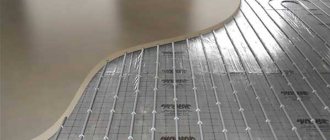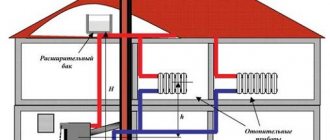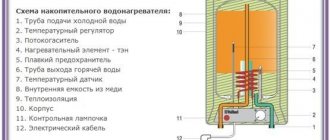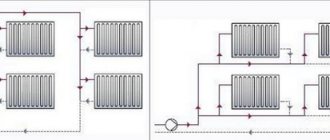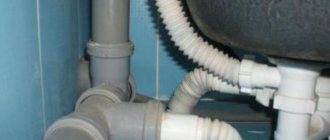Signs of poor heating
The first sign of heating problems is cold radiators.
When rooms are not heated enough in winter, you can feel it right away. Problems with heating in an apartment make themselves felt by discomfort for the inhabitants, the appearance of dampness on the walls and strange noises spreading through metal pipelines throughout the entire house.
Problems that arise with the heating system can be characterized by a number of symptoms:
- the system as a whole is functioning poorly;
- the heat supply on different floors is not the same;
- radiators in one room are hot, in another barely warm;
- the “warm floor” system warms up unevenly;
- noise and seething in the pipes is heard;
- Coolant is leaking from pipes or radiators.
Steel pipe repair
How to fix a leaking heating pipe? If the problem is observed in threaded connections, then the connection will need to be disassembled, and then a new layer of winding will be applied.
When disconnecting, you must act very carefully, as you can accidentally break the seal. To make disassembly easier, you can preheat the connections. If a leak is observed at the joint or on the body of the pipe, then gas or electric welding will be required.
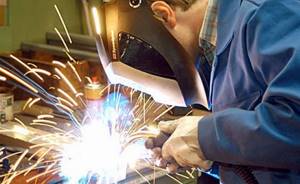
Repairing a metal heating pipe using welding
Causes of heating problems
Most residents of city apartments believe that they have no need to know the structure of engineering systems. Any central heating problems that arise in their high-rise building must be resolved by the employees of the management company. And it is right. It is better if only one responsible owner is involved in all matters. Indeed, in an apartment building, problems with heating often arise precisely because of unauthorized interventions in the smooth functioning of the heating system.
But individual homeowners are forced to understand problems with heating in a private home and keep the situation under control. The owner of the house must know at least in general terms about the causes of problems and be able to correct them.
The following reasons can lead to problems with the heating system:
- the system is not properly designed;
- equipment does not meet design requirements;
- the system was unbalanced due to unauthorized connections;
- installation was performed poorly;
- air pockets interfere with coolant circulation;
- radiators are installed incorrectly;
- pipelines have become unusable;
- the tightness of the connections is broken.
Let's take a closer look at each of these reasons and ways to eliminate heating problems in an apartment and in a private house.
What to do if the batteries in a country house are leaking
If you live in a country house, the situation is somewhat simplified by the fact that the system can always be drained and a thorough battery repair can begin. This, of course, is also troublesome, so if the situation is not so catastrophic, you can save yourself using the methods listed above and, after waiting for the end of the heating season, replace the worn-out elements of the heating system.
Let's look at which methods are suitable in a given situation, since in hard-to-reach places it is not possible to use some of them.
If the pipe connection is leaking
:
- a homemade or factory-made clamp is suitable as an ambulance; how to apply and secure it is described above;
- If it leaks from a threaded joint, you need to pour a little alcohol onto the tow and spread the butyral with phenolic glue (BF glue, sold in the store). The glue dissolves in alcohol, flows onto the thread, the alcohol evaporates, the glue stops the leak;
- try to repack the connection: if there is a shut-off valve, disconnect the battery, then slowly twist the nut in different directions, without making any effort, so as not to break the thread; then remove the remaining sealant, old tow, degrease the surface of the pipe; then reel in fresh winding and coat everything with sealant; After this, carefully tighten the nut with a wrench until it stops.
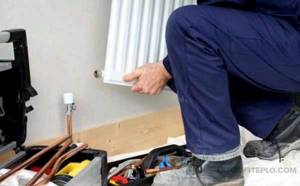
Eliminating leakage in the heating pipe to the radiator
If there is a leak between the battery sections
:
- To ensure that the battery no longer leaks, it is better, of course, to disassemble it. This is possible if there is a shut-off valve and the battery can be disconnected. It would be good to replace several sections, but you can clean the inside and change the gaskets, which over time are corroded by water and corrosion;
- if it is not possible to disassemble, use available means: “cold welding” (how to make repairs is described above) or epoxy glue. The method of applying it is the same as for the gypsum-cement mixture, but the strips of fabric need to be made a little narrower. For greater reliability, you can put a clamp on top.
Errors in heating system design

Due attention must be paid to the development of the heating system project so that in the future the problems of heating a private house do not poison everyday life. Attempts to save money on proper design result in trouble. For example, when starting up a fully installed system, problems with heating radiators are suddenly discovered, some of which do not heat up. This means that the system was initially designed incorrectly and will have to be redone.
Design can only be entrusted to specialists who will take into account many factors. Among them: the layout of the house, the volume of heated premises, the degree of heat loss, etc. It is also important to plan the required slope of horizontal sections of pipelines. Also, the main technical parameters of the required equipment can only be determined on the basis of thermal engineering calculations.
To reliably heat a house, the heating boiler must have a power of at least 1 kW for every 10 m² of room area with a ceiling height of up to 3 m.
Repair of metal-plastic pipes
If your system is equipped with metal-plastic pipes, then most likely the entire area in which the damage occurred will need to be replaced. The damaged area will need to be cut out, and a new one will need to be installed using press fittings or compression fittings. A fistula on a heating pipe for metal-plastic heating usually occurs precisely at compression-type connections.
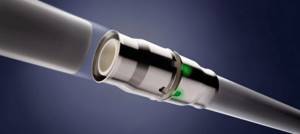
Repair of metal-plastic pipes
Inappropriate home heating equipment

With the current wide range of heating equipment, it is easy to make a mistake and purchase the wrong one. To avoid problems in the heating system, it is necessary to focus on the compliance of all its elements with the approved project. You need to buy radiators only of the type and with the number of sections as planned. All pipeline connecting parts, control and shut-off valves must be mutually compatible.
Heating problems in a private home often arise due to poor circulation. Circulation pumps help increase the speed of coolant movement in the pipes. But you need to select the right pump model correctly so that there is no noise in the pipes during its operation.
When arranging modern housing, old iron pipes are increasingly being replaced by more practical metal-plastic and polypropylene pipes. The absence of problems in each specific heating system will depend on their compliance with the specified project conditions. Although plastic pipes are lightweight and easy to assemble, it is better to entrust a specialist with the correct selection and subsequent installation of these products.
It is important to know that not all types of plastic pipes are suitable for heating systems. Some of them may become deformed or burst under the influence of hot water.
Prevention
Leaking heating system pipes are easier to prevent than to correct the situation later. To avoid such a situation, only suitable materials are used for the construction. This applies to plastic pipes.
For the heating system, only special materials , and not pipes for cold water. To avoid leaks, the condition of the pipes is also regularly assessed. If the slightest defect is detected, it is recommended to replace the material.
When a heating system pipe leaks, it is advisable to repair the defect immediately. If timely measures are not taken, this will lead to pipe bursting.

A leak in a threaded connection of a metal pipeline leads to many troubles: from dampness in the room to flooding of the apartment from below. A radical solution to a large-scale problem requires the services of a plumber, but in some cases you can deal with the leak yourself.
Heating system imbalance
Serious problems with heating in an apartment building arise when residents begin to repair and remodel their apartments. Spontaneous, uncontrolled installation of new radiators and heated floors leads to an imbalance in the system. As a result, circulation in the system is disrupted; on some floors the radiators are hot, while on others the residents are cold. The management company’s specialists can balance the distribution of coolant through the risers, but problems with heating in individual apartments still remain.
If your neighbors changed their heating appliances and removed their thermostats, then it is not surprising that water simply will not flow through the pipes into your apartment. And it will be possible to solve such a heating problem only by removing the thermostat in your home as well.
Another opportunity to really increase the heat supply to your apartment is to follow the example of your neighbors and change the batteries. If you install aluminum or bimetallic instead of cast iron, their heat transfer will be much better.
It is prohibited to change radiators without permission; you must obtain permission!
The heating system can also become unbalanced in a private home. Then radiators located closer to the boiler heat up more than those further away. The balance will have to be restored in this way: close the control taps and limit the flow of coolant flowing to the nearby radiators, so that more heat flows to the distant ones.
Types of faults and methods for eliminating them
Experts identify several types of faults that lead to leaks . Each defect has its own solution to the problem.
How to fix a poorly welded seam
A poorly executed joining seam is one of the types of faults. To solve this problem, it is recommended to use lead cones and cement mortar. Regardless of the chosen method, the operating algorithm is the same:
- free the joint from worn-out residues (metal or repair mortar);
- the seam from dirt and corrosion and remove excess liquid with a rag.
Rules for using lead:
- fix the cones in the defect ;
- prepare a cement mortar - for 10 parts of the material , take 1 part of water and knead the composition;
- Apply the resulting product over the cone and wait until it hardens .
Cement is also used without cones. Work algorithm:
- prepare cement mortar and prepare a medical bandage;
- soak the bandage in the solution and fix it in the defect;
- Apply a layer of cement on top so that it completely covers the bandage , and wait until the solution has completely hardened.
Reference! The cement hardens within a day after applying the solution.
Broken radiator plate
Another type of malfunction is a broken radiator plate . Procedure to correct the situation:
- turn off the heating system;
- reset the riser system;
- disconnect the battery, first placing a container under the battery in case there is any remaining water in the riser;
- Use a radiator wrench to disconnect the part where the damage occurred;
- fix the new nipple and tighten it;
- install the battery to the system and run the coolant.
Cold welding
To eliminate a leak in the radiator plate, use cold welding:
- turn off the heating system;
- reset the riser system;
- clean the defect from dirt and rust;
- Treat the leak area with cold welding;
- 40 minutes after the material has hardened, run the coolant into the system.
Photo 1. Cold welding for steel and cast iron batteries and pipes, 50 g, .
Cement-plaster cast
As in the case of a poorly welded seam, a cement-plaster cast . The bandage is impregnated with cement mortar, fixed to the problem area and covered with a layer of mortar on top. After the composition hardens, the flow stops.
Salt
To eliminate the defect on the battery, use table salt with a cement-plaster bandage. Prepare a cement mortar, soak the bandage in it and sprinkle salt on top. After this, the damage is sealed with this bandage and fixed with fasteners.
How to repair a leak between battery sections
If a leak occurs between the sections of the radiator, then eliminate such a defect using a clamp . It is tightened on the defect by a screw and this measure will not last long, but at the first opportunity more serious measures are taken.
If you don’t have a special clamp at hand, make it yourself . For this purpose, steel and aluminum plates are used. They are connected with a bolt and tightened at the defect site.
Before installing the clamp, cover the damaged area with a rubber band or a rag soaked in glue.
Poor quality installation of the heating system
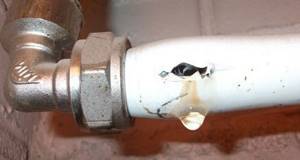
It happens that a new, recently installed radiator does not want to heat up.
Others in the system before and after it heat up normally, but this one does not. The reason is poor coolant circulation. The reason for the problem with the heating radiator could have been an oversight by the installer. Probably, when welding a polypropylene pipe, he overheated it too much, and as a result of melting, the internal diameter decreased. In such cases, the installer is obliged to redo his poor-quality work free of charge.
To avoid problems with the heating system, all pipes and fittings included in its composition must be a securely installed structure.
Elimination of leakage of a threaded connection when the water supply is turned off
After shutting off the water and freeing the pipe from the fittings using a pipe wrench, you need to make sure that there is no crack, since in this case only replacing a section of the pipe is effective.
If there is no crack, the steps are as follows:
- the connection is cleaned of rust;
- wrap tow on the thread in combination with paint or Unipack composition, FUM tape or a special thread;
- tighten the connection manually;
- tighten using a pipe wrench.
Air locks in heating

If the radiators are not heated in any of the rooms, it means that the air accumulated in the system is preventing the free movement of the coolant. An air lock can form due to many reasons, including the following:
- air enters when water is drained from the system and then refilled;
- Oxygen is released from water when heated;
- a faulty expansion tank creates a local area of low pressure;
- air is sucked into the system through connections with broken seals;
- air diffusion occurs through the surfaces of plastic pipes.
Air bubbles can accumulate either at the highest point of the piping system, or only in one of the radiators. Then the bottom of the battery will be hot and the top will remain cold. The presence of air in the pipes also provokes the appearance of unpleasant gurgling sounds. Most often, heating devices on the top floor of a building stop heating.
The more complex the configuration of the heating system in your home, the slower it should be filled to avoid air locks.
Due to air bubbles, not only does the heat supply through the piping system stop, but also corrosion of metal elements begins. The smooth operation of the circulation pump is also disrupted.
The use of simple technical devices will help get rid of the problem of clogging the heating system with air locks.
The most effective way to remove air from a closed heating system is to use automatic air vents. If they are mounted in several problem areas at once, then the air from each group of system elements will be released as it accumulates.
In addition to automatic ones, there are also manual air vents (Maevsky valve). Such a device is installed at the end of the radiator, located on the topmost floor. You can learn how to use it from the video presented here.
How to bleed air through the Mayevsky tap
Depending on how the heating system is designed, it may sometimes be necessary to bleed air through an expansion tank in the attic. The circulation pump can also help expel air pockets from the system.
Leak elimination process
There are several ways to fix a leak. The choice of method depends on where the problem occurs.
If a leak appears on a flat area, then the most common way to eliminate it is to retighten the material. Wrap the damaged area with a piece of soft elastic, the size of which is larger than the size of the leak. Tighten the pipe over the material with a clamp or wire.
Important! To make the screed strong and eliminate the problem for a long time, it is recommended to use a special plumbing pipe clamp. It is sold at any specialized retail outlet.
If a leak has formed on a fitting or thread, then a screed is also used to eliminate the leak.
The first layer uses a long piece of rubber instead of compacted rubber. The material is wrapped around the fitting along with the end of the pipe, which will help level this section of the system.
The bandage is then secured with clamps. This manipulation eliminates the problem.
When a leak occurs at the junction of sections and the defect is small, a fabric soaked in glue will eliminate the problem. A bandage is applied to the problem area. When the glue hardens, the flow will stop.
Attention! Each of the proposed methods only temporarily solve the difficulties. At the end of the heating season, it is recommended to carry out a full repair by replacing or welding the leaky section.
How to cover up a leaking radiator
To eliminate leaks special mixtures to seal the pipe. The so-called cold welding is in high demand. The composition is applied to the material and after it hardens, the flow stops. are also used to solve the problem . Such products are sold in specialized retail outlets.
Features of repairing current batteries in winter
If the heating system leaks in the summer , the problem can be solved by replacing the leaky pipe. The structure is disconnected from the water supply and repairs are carried out.
In winter, turning off the heating system for an extended period will not work. To solve the problem, only temporary measures .
At the end of the heating season, the pipes where the defect has formed are replaced or the seams are welded.
If a breakthrough occurs, it is eliminated by replacing the pipes, regardless of the time of year.
Incorrectly installed heating radiators
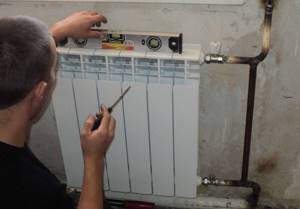
The issue of correct installation of radiators is most relevant for private homeowners, since they themselves have to regulate the heating in their home. Replacing radiators yourself should be treated with responsibility, because installing them without preliminary calculations can add unnecessary problems to the heating system.
For example, the installation was done according to the instructions, but some of the radiators are working at half capacity. It turns out that it is skewed and the coolant cannot fill it entirely. And the reason is that the heavy multi-section radiator was hung on only two brackets, although it would have been more reliable to use four. As a result, the metal structures bent and the internal tubes were deformed.
The reliability of the radiator also depends on its location. The bottom edge of the battery should be raised above the floor by 10 cm, and there should be 2-3 cm of free space between the radiator and the wall.
Each radiator must hang on reliable brackets without sagging, play or distortion.
How to protect threaded connections from leaks?
The best way to avoid leaks is to make the threaded connection correctly from the beginning.
Selecting a compacting winding
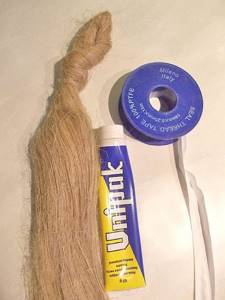
- A universal material used as a seal is tow (linen fiber). It is able to withstand high temperatures and pressure. However, since linen is a natural material, it is susceptible to rotting. To prevent this process, accompanying materials are used in combination with linen winding: oil paint, Unipack ointment, some use litol or grease. Associated compounds can become a serious obstacle when dismantling the connection. In brass and bronze connections, flax fiber must be used carefully, since a thick layer can cause cracks in the threads.
- FUM tape and thread are made of synthetic materials, so they do not need protection from rotting. They are cleaner to work with, but cannot be used for lug nuts and locknuts.
Reducing clearance in old heating pipes
Lime deposits and rust reduce the internal diameter of the metal pipe by more than half.
In old “Khrushchev” buildings, problems in the heating system are obvious and predictable. There, the service life of the pipelines has long expired, and therefore they cause not only a decrease in heat, but also accidents. Over many decades, the pipes become so clogged with sediment that they are unable to provide normal circulation. The decision must be drastic - replace all the pipes.
In addition, a decrease in pressure in the system is caused by the formation of scale on the heat exchanger of the heating boiler. Using too hard water leads to such consequences. To prevent a similar problem with heating devices, special water softening agents are added to the system.
How to fix a leak and solutions
How to repair a leak in a heating pipe depends on where it occurred: at the junction of sections, at the connection of the radiator with the pipe, on the pipe itself. Repairs are carried out in different ways, let's look at the main methods.

Heating pipe is leaking at the junction
Important! If it drips from the pipeline through which hot water is supplied for heating, and this section is under pressure, then the fistula can be eliminated for a very short time. In this case, you will have to call the emergency service and carry out major repairs.
Cold welding
As a rule, it is used at the junction of two battery sections and helps to temporarily close the damaged area. It is made using adhesive-sealant, which can be purchased at a hardware store. It has a special composition that crystallizes when it dries and fills the hole.

Applying “cold welding” to a metal pipe
- thoroughly clean the damaged area from paint and rust using a brush with metal bristles or sandpaper;
- degrease, alcohol, solvent, acetone are suitable for this;
- cut off a piece of sealant, knead with wet hands until smooth;
- press well into the damaged area on the heating radiator and smooth it out;
- until the composition hardens completely, it must be pressed tightly to the surface;
- Curing time is approximately 20-25 minutes, complete polymerization is after 3 hours.
Advice! Be sure to wear protective gloves, as the sealant is a chemically active compound that corrodes the skin.
Cement-plaster cast
If a hole is found on the heating pipe or the junction of the battery sections, you can make a cement-plaster bandage; for this, prepare the following consumables:
- medical bandage, a piece of gauze or thin cotton fabric;
- alabaster (plaster);
- cement;
- bucket or basin with water.

Repairing a leak with a cement bandage
- dilute cement in water, mixing it with gypsum, the consistency should be like that of rich sour cream;
- take strips of fabric or bandage 25-30 cm long, soak in the resulting composition;
- wrap a cloth around the damaged section of the pipe;
- overlays are made until the bandage is strong and tight.
Range of procedures
Heating maintenance and repair consists of the following activities:
- elimination of leaks that occur in pipelines, devices and shut-off or control valves;
- replacement of damaged sections of devices and taps;
- elimination of “reverse slopes” appearing on pipelines;
- installation of air-bleeding valves in areas where it is impossible to level out reverse slopes or air plugs;
- elimination of breakdowns that occur in the control unit or boiler heating system;
- testing and, if necessary, replacement of failed measuring and control instruments.
Maintenance of the heating system of a private home includes preventive work on various elements, including washing and painting. The heating system is flushed and adjusted every year at the end of the season.
Summarizing
Problems with the operation of the heating system are a rather unpleasant thing, because they only appear during the heating season. And their elimination is associated with certain difficulties - after all, you have to turn off the heating during repair work. Timely inspection and preparation of heating for winter will avoid these troubles.
The video shows how to fix several common heating system defects.
Did you like the article? Subscribe to our Yandex.Zen channel
Blockage in the pipeline
When a riser (a separate device) becomes clogged, the resistance of sections of heating systems increases and the flow rate of the coolant circulating through them decreases, as a result the average temperatures of heating devices in these sections decrease.
When a riser in a two-pipe system is clogged, a normal temperature is observed on the surfaces of all heating devices connected to this riser. After a blockage, the temperature drops sharply, which occurs as a result of a reduction in coolant flow in the heating devices of the system or a complete stop of circulation through these devices.
When the hoses or heating devices are clogged, the temperature on the surface of individual devices decreases, while the entire riser of the system warms up normally. Finding clogs is a complex and time-consuming job.
1. Methods for identifying blockages. In single-pipe systems, finding a blockage in the riser by measuring the temperature, as a rule, does not give positive results, since the coolant cools evenly throughout the riser before and after the blockage. The acoustic method involves listening to the system. In places where the flow area of the pipeline is narrowed due to a blockage, the speed of the coolant increases sharply, which leads to an increase in noise at the site of the blockage. 2. Removing blockages. After determining the location of the blockage, it is removed by hydraulic, pneumatic flushing or cleaning. Before flushing, the entire system is inspected: leaks are checked, disassembled and cleaned. Hydraulic flushing involves creating high speeds by constantly flowing water through a clogged pipeline. To do this, water is discharged into the drain. In some cases, network, circulation or other pumps are used to increase speed. The above-described flushing method allows you to eliminate blockages caused by light particles and clean pipelines in places where the water velocity is relatively high. In areas where the water velocity is low (in radiators, large-diameter pipelines), flushing is ineffective, since heavy particles settle from the flushing water flow. The duration of washing depends on the degree and nature of contamination, as well as on the diameter and length of the area being washed. Washing is carried out until the water-air mixture being removed is completely clarified. 3. Cleaning of pipelines. Heating system pipelines are cleaned if it is impossible to remove the blockage by flushing. To do this, the section of the pipeline where the blockage is expected is turned off and the water is drained from it. Then the pipes are disconnected from the section of the pipeline with the blockage and the blockage is cleared with thick elastic wire. After punching through the blockage, a brush is attached to the end of the wire, with which the blockage is removed. During the cleaning process, pieces of dried mortar, soil and other objects that caused the blockage fall down. 4. Removing dirt with water. Loosened dirt can also be removed with water. To do this, hoses are put on the ends of the pipeline. The upper hose is connected to the mixer, and the lower hose is lowered into a sanitary fixture (sink or toilet). Open the mixer and pass water through the pipeline.

